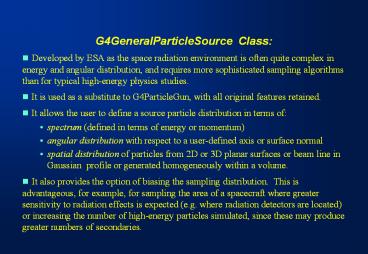G4GeneralParticleSource Class: - PowerPoint PPT Presentation
Title:
G4GeneralParticleSource Class:
Description:
It is used as a substitute to G4ParticleGun, with all original ... of nuclei, and nuclide. decays to ignore. User input defines. Biasing of branching ratios ... – PowerPoint PPT presentation
Number of Views:30
Avg rating:3.0/5.0
Title: G4GeneralParticleSource Class:
1
- G4GeneralParticleSource Class
- Developed by ESA as the space radiation
environment is often quite complex in energy and
angular distribution, and requires more
sophisticated sampling algorithms than for
typical high-energy physics studies. - It is used as a substitute to G4ParticleGun,
with all original features retained. - It allows the user to define a source particle
distribution in terms of - spectrum (defined in terms of energy or momentum)
- angular distribution with respect to a
user-defined axis or surface normal - spatial distribution of particles from 2D or 3D
planar surfaces or beam line in Gaussian profile
or generated homogeneously within a volume. - It also provides the option of biasing the
sampling distribution. This is advantageous, for
example, for sampling the area of a spacecraft
where greater sensitivity to radiation effects is
expected (e.g. where radiation detectors are
located) or increasing the number of high-energy
particles simulated, since these may produce
greater numbers of secondaries.
2
G4GeneralParticleSource Features
3
- G4 Radioactive Decay Model
- Long-term (gt1?s) radioactive decay induced by
spallation interactions can represent an
important contributor to background levels in
space-borne ?-ray and X-ray instruments, as the
ionisation events that result often occur outside
the time-scales of any veto pulse. The
Radioactive Decay Model (RDM) treats the nuclear
de-excitation following prompt photo-evaporation
by simulating the production of ?, ?-, ?, ? and
anti-?, as well as the de-excitation ?-rays. The
model can follow all the descendants of the decay
chain, applying, if required, variance reduction
schemes to bias the decays to occur at
user-specified times of observation.
4
The branching ratio and decay scheme data are
based on the Evaluated Nuclear Structure Data
File (ENSDF), and the existing Geant4
photo-evaporation model is used to treat prompt
nuclear de-excitation following decay to an
excited level in the daughter nucleus. (Atomic
de-excitation following nuclear decay is treated
by the Geant4 EM physics processes.) The RDM has
applications in the study of induced radioactive
background in space-borne detectors and the
determination of solar system body composition
from radioactive ?- ray emission. On ground it is
used in the Dark Matter Experiments
- Variance Reduction in RDM
- Times sampled in Monte Carlo simulation of
radioactive decay often may not correspond to the
times of observation leading to inefficient
simulation. Biasing the sampling process and
modifying the weights of the decay products
significantly improves efficiency.































